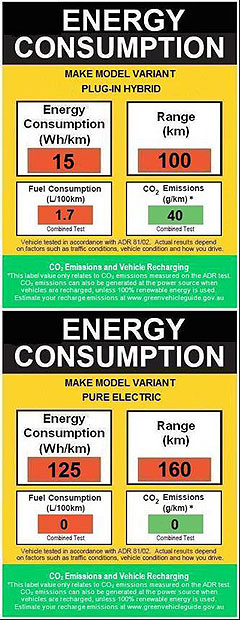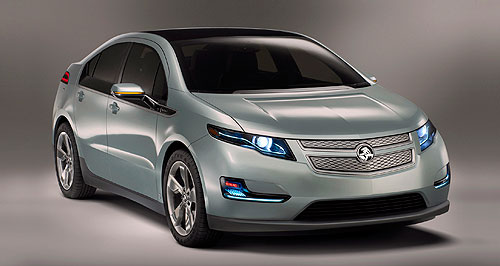Make / Model Search
News - General NewsWatts up with electric vehiclesWhat's Watts: Consumers will need to brush up on their 'watt-hours per kilometre' calculations under new labelling for plug-in cars. New labelling regulations for EVs, plug-in hybrids await next government’s signature17 Aug 2010 NEW regulations governing the modern breed of electric and plug-in hybrid ‘range extender’ vehicles are set to be signed into law in Australia after the federal election, providing a single uniform guide for consumers to the kilometre range and energy consumption of plug-in cars. The amended Australian Design Rule governing fuel consumption labelling – ADR81/02 – has been drawn up by the federal transport department, requiring manufacturers to comply with an official test procedure and labelling of vehicles with “external charge capacity”. The familiar yellow fuel-consumption label placed on the windscreen of all new cars as a guide to buyers will be replaced with a new ‘energy efficiency’ label that includes an energy consumption figure – expressed in Watt-hours per kilometre – and electric-mode range in kilometres. Electric vehicles will be tested at 50km/h under the new international protocol, called ECE R 101, developed in Europe and adopted by Australia. After running the test procedure, the battery will be recharged to calculate the expended energy. Controversially, pure electric vehicles will be automatically accorded a ‘zero’ emissions rating and maximum score of 10 for both greenhouse and air pollution ratings. ‘Range extending’ hybrid vehicles – armed with a back-up internal combustion engine that kicks in to generate more power when the batteries become depleted – will be subjected to two tests – the first in battery mode like the pure EVs, and the second in “battery-depleted mode” – with the engine running – to record fuel consumption (L/100km) and carbon dioxide emissions (g/km) in the same way as conventional petrol or gas-fuelled cars. Figures from the two modes will be combined in a mathematical calculation to arrive at a litres per 100km fuel figure and a CO2 grams per kilometre emissions output.  Left: Proposed 'energy efficiency' label for plug-in hybdrid vehicles. Below: The 'pure electric' label. Left: Proposed 'energy efficiency' label for plug-in hybdrid vehicles. Below: The 'pure electric' label.In a mythical example shown in a transport department label mock up for a plug-in hybrid, the energy consumption was given as 15Wh/km, the range was 100km, fuel consumption 1.7L/100km and CO2 emissions 40g/km. By comparison, the current standard (non-plug-in) Prius hybrid has a combined fuel economy reading of 3.9L/100km and a CO2 figure of 89g/km. The information will be spelled out on the federal government’s Green Vehicle Guide website so consumers can compare vehicle performance. The site is likely to include calculation tools so consumers can also work out CO2 emissions from the electric recharging process and “well-to wheel” emissions. Standard hybrid cars – vehicles such as the current Toyota Prius and Honda Insight that generate their own electricity and can’t be recharged from a power point – will continue to be tested for fuel consumption like conventional petrol cars. The EV test protocol established by the United Nations Economic Commission for Europe (UNECE) will bring Australia into line with Europe and a raft of nations that are signatories to the UN World Forum for Harmonisation of Vehicle Regulations. Federal Chamber of Automotive Industries CEO Andrew McKellar told GoAuto that the changes were in the federal government pipeline and “close at hand”. “I believe that once the election is resolved, the proposal is sitting in the minister’s in-tray, awaiting the incoming government, whoever that should be,” he said. Asked if he thought the ADR could be signed off this year, Mr McKellar said: “It may well be.” With the arrival of the first fleet of 20 full electric Mitsubishi i-MiEV vehicles in Australia last week, the urgency for a standard testing procedure has intensified. Toyota also has imported a small fleet of Prius Plug-In Hybrid cars for fleet testing, while Nissan, Renault and Tesla have plans to introduce full electric cars to the Australian market. Every other major international car-maker has signalled its intention to introduce such vehicles within the next five years, and most are expected to launch them in Australia. The challenge to date has been how to compare the performance of full electric vehicles (EVs) and plug-in hybrids and their numerous powertrain configurations. The difficulty was highlighted when General Motors claimed 230-miles-per-gallon (1.2 litres per 100km) city cycle fuel efficiency from its plug-in ‘range-extender’ Volt in the United States. The claim was an interpretation of the Volt’s everyday performance, based on its range of up to 64km on battery power before the petrol engine kicks in to generate sufficient electricity for a further 483km. Now, the Volt – and all similar plug-in cars – will have to be tested in both electric and petrol modes as part of the new-model certification process when it arrives in Australia to join the Holden range in 2012. Under this scenario, the Volt is still expected to comfortably beat the combined fuel economy figure of the best petrol and diesel cars on the market. As the kilometre range of full-electric and plug-in hybrid vehicles is expected to vary dramatically according to battery size and type, level of technology and cost, it will be up to consumers to make a value judgement according to price and other factors. Mr McKellar said the purpose of the new testing and labelling rules were to provide a consistent basis for comparison. “There will be standard consumer labelling so that when people go to purchase a vehicle they can see what its range and energy consumption are,” he said. As well as the energy consumption labelling change to the ADRs, Australia has adopted international rules governing electric safety controls, mainly to minimise the chance of electrocution in crash and workshop situations.  Read more |
Click to shareGeneral News articlesResearch General News Motor industry news |












Facebook Twitter Instagram